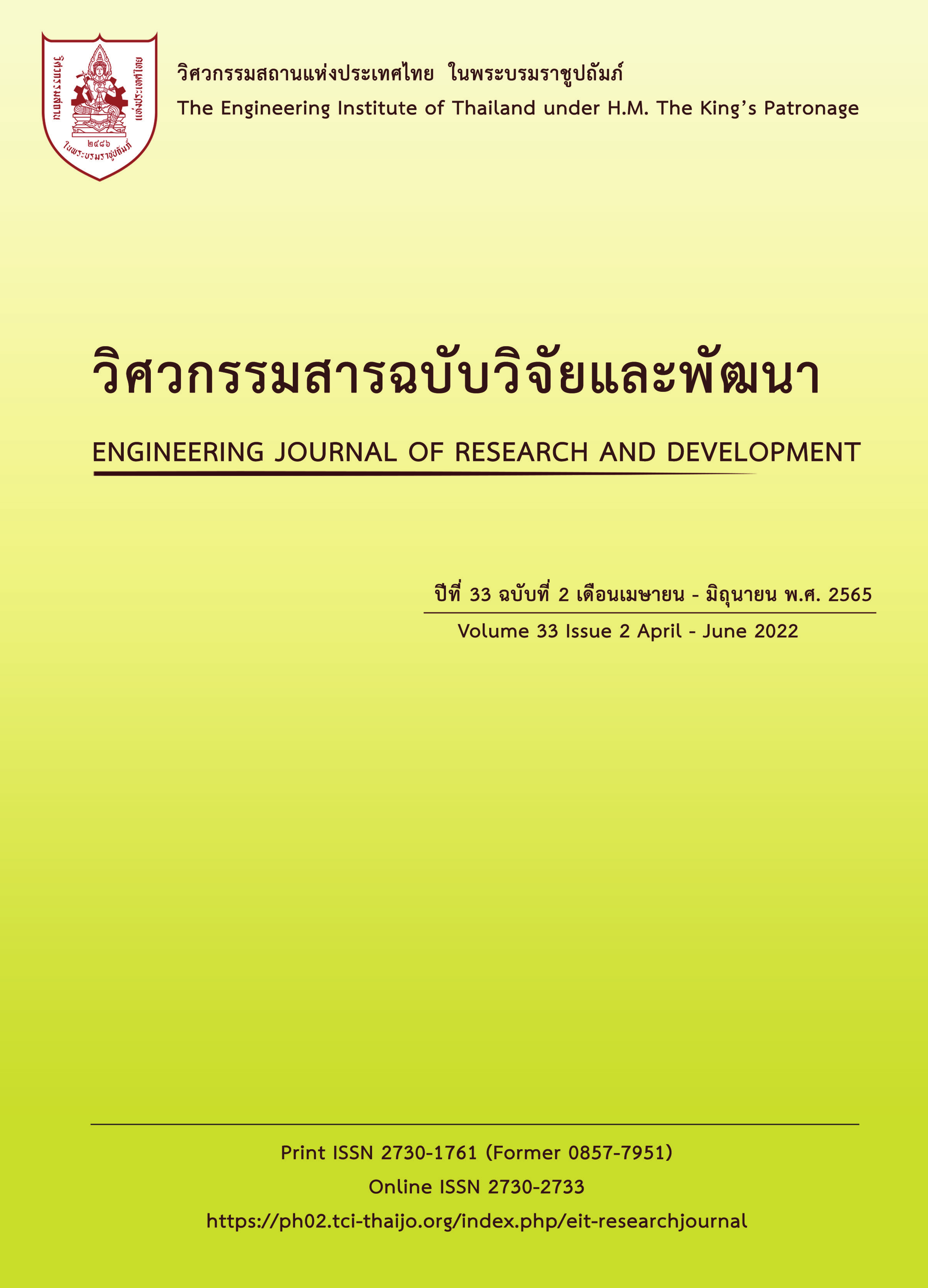BIOMASS PELLETS FROM SUGARCANE FILTER CAKE AND BAGASSE FOR HOUSEHOLD CHARCOAL STOVE
Main Article Content
Abstract
The objective of this research was to determine the optimal proportion of biomass pellet fuel from a mixture of sugarcane filter cake and bagasse, which is a waste of energy for a household charcoal stove. The research methodology was mixing the filter cake with bagasse at various proportions and then extruded it into 10 mm diameter biomass fuel pellets and then use it as energy for boiling water on a household charcoal stove (Water Boiling Test, WBT). The results showed that the proportion of filter cake 20% at 10% humidity gave the most suitable properties with the fuel consumption was 189±3.17 g/1,000 ml of water, the thermal efficiency was 14.04±0.22%, the boiling time of the boiling water was 15.94±0.14 minutes, burning fuel consumption rate 0.71±0.01 kg/h, specific fuel consumption 0.19±0.01 which was equivalent to the firepower of 2,547±54.21 W.
Article Details

This work is licensed under a Creative Commons Attribution-NonCommercial-NoDerivatives 4.0 International License.
The published articles are copyright of the Engineering Journal of Research and Development, The Engineering Institute of Thailand Under H.M. The King's Patronage (EIT).
References
สำนักคณะกรรมการอ้อยและน้ำตาลทราย. รายงานประสิทธิภาพการผลิตน้ำตาลทราย ฤดูการผลิต 2562/63. กรุงเทพมหานคร: สำนัก คณะกรรมการอ้อยและน้ำตาลทราย กระทรวงอุตสาหกรรม, 2563.
Campiteli, L. et al. The impact of applications of sugar cane filter cake and vinasse on soil fertility factors in fields having four different crop rotations practices in Brazil. Científic, 2018, 46, pp. 42. DOI: 10.15361/1984-5529.2018v46n1p42-48.
Salmeia, K.A. et al. Flammability of cellulose-based fibers and the effect of structure of phosphorus compounds on their flame retardancy. Polymers, 2016, 8 (8), pp. 293. DOI: 10.3390/polym8080293.
George, P.A. et al. Residue from sugarcane juice filtration. Waste Biomass Valor, 2010, pp. 407-413. DOI: 10.1007/s12649-010-9046-2.
Pajampa, Kaittisak and Wongwuttanasatian, Tanakorn. Biomass pellets produced from filler cake as waste to energy in sugar industry. International Conference on Future Environment and Energy, Thailand, 2019, pp. 1-7. DOI: 10.1088/1755-1315/257/1/012021.
Bailis, R. et al. The water boiling test. Shell Foundation, 2007.
Office of the Cane and Sugar Board. Annual report 2018. Ministry of Industry, Thailand, 2018.
Encyclopedia Britannica. Bagasse. Encyclopedia Britannica, 2016. https://www.britannica.com/technology/bagasse. [10 April 2021]
Larsen, N.A. Sugarcane filter press mud as a substrate for nursery hardening of tissue culture bananas. Dissertation. University of Florida, USA, 2015.
Rein, P. Cane Sugar Engineering. 2nd ed. Bartens, 2016, pp. 219-266.
Katinonkul, Watcharee. Biomass pellets Natural energy. Department of science service, Ministry of science and technology, Thailand, 2019.
Rajaseenivasan, T. et al. An investigation on the performance of sawdust briquette blending with neem powder. Alexandria Engineering Journal, 2016. DOI: 10.1016/j.aej.2016.07.009.
American Society for Testing and Materials. ASTM D5865/D5865M-19 Standard test method for gross calorific value of coal and coke. West Conshohocken: USA, 2019. DOI: 10.1520/D5865_D5865M-19.
American Society for Testing and Materials. ASTM D3172-13 Standard practice for proximate analysis of coal and coke. West Conshohocken: USA, 2013. DOI: 10.1520/D3172-13. DOI: 10.1520/D3173_D3173M-17A.
American Society for Testing and Materials. ASTM D3173/D3173M-17a Standard Test Method for Moisture in the Analysis Sample of Coal and Coke. West Conshohocken: USA, 2017. DOI: 10.1520/D3173_D3173M-17A.
American Society for Testing and Materials. ASTM D3174-12(2018) e1 Standard Test Method for Ash in the Analysis Sample of Coal and Coke from Coal. West Conshohocken: USA, 2018. DOI: 10.1520/D3174-12R18E01.
American Society for Testing and Materials. ASTM D3175-20 Standard Test Method for Volatile Matter in the Analysis Sample of Coal and Coke. West Conshohocken: USA, 2020. DOI: 10.1520/D3175-20.
Sun, J. X. et al. Isolation and characterization of cellulose from sugarcane bagasse. Polymer Degradation and Stability, 2004, 84 (2), pp. 331- 339. DOI: 10.1016/j.polymdegradstab.2004.02.008.
Saelee, K. et al. Extraction and characterization of cellulose from sugarcane bagasse by using environmental friendly method. The 26th annual meeting of the Thai society for biotechnology and international conference. Thailand, 2014, pp. 162-168.
Danso, H. et al. Effect of fibre aspect ratio on mechanical properties of soil building blocks. Construction and Building Materials, 2015, 83, pp.314-319. DOI: 10.1016/j.conbuildmat.2015.03.039.
สำนักงานมาตรฐานผลิตภัณฑ์อุตสาหกรรม. มาตรฐานผลิตภัณฑ์อุตสาหกรรม เชื้อเพลิงชีวมวลแข็งอัดเม็ด. กรุงเทพมหานคร: มาตรฐานสำนักงาน มาตรฐานผลิตภัณฑ์อุตสาหกรรม กระทรวงอุตสาหกรรม, 2560.
Gil, M.V. et al. Mechanical durability and combustion characteristics of pellets from biomass blends. Bioresource Technology, 2010, 101 (22), pp. 8859-8867. DOI: 10.1016/j.biortech.2010.06.062.
Bhatt, M.S. Effect of ash on the efficiency and capacity of coal fired ~ thermal power plants. The Journal of CPRI, 2004, 1 (1), pp. 71-78.
Chaiwong, K. et al. Effect of inlet air flow on thermal efficiency of bio-char stove from agricultural waste RMUTL Engineering Journal, 2016, pp. 37-42.
Tantisattayakul, T. et al. Community-based renewable energy from biomass briquettes fuel from coconut leaf. Thammasat Journal of Science and Technology, 2015, 23 (3), pp. 418-431.
Obi, O.F. et al. Energy performance of biomass cookstoves using fuel briquettes. Biofuels, 2017, 11 (4), pp.1-11. DOI: 10.1080/17597269.2017.1374769


